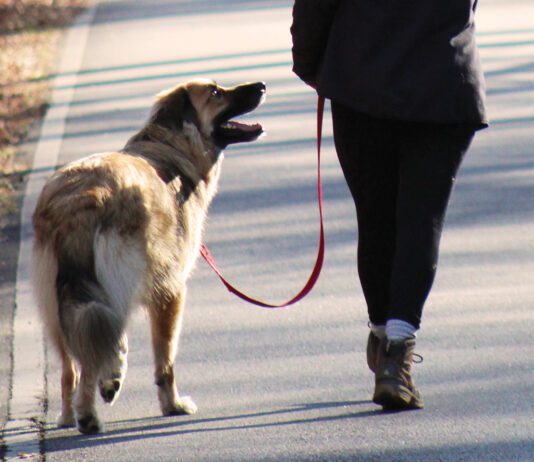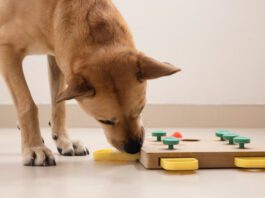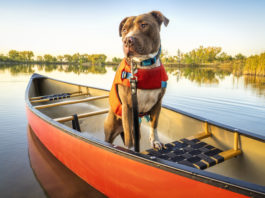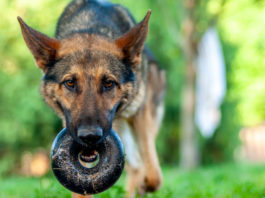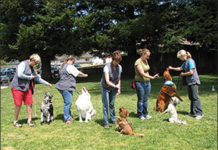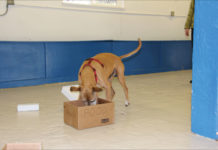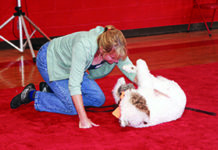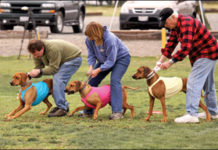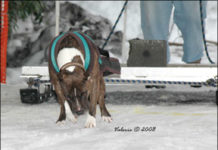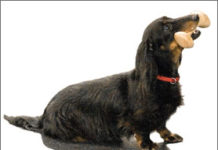5 Ways Teaching Your Dog to Do Tricks Can Improve Training
High-five. Fetch. Jump through a hoop. Spin, twirl, and take a bow. There is no doubt that tricks are fun to train, and even more fun to show off to friends and family. But they are so much more than just a good time! Here are five things tricks can do for you, your dog, and your training.
Sniff This; You’ll Feel Better
Shelter volunteer Katherine Kekel stood at the end of a long hallway and struggled to keep a grip on Tia, a pit bull-mix, as the dog strained at her harness. Unable to contain the dog any longer, Katherine let go. The well-muscled dog sprinted down the hallway, put on the brakes, and made a sharp right turn into a small room. The hunt was on! Tia was playing K9 Nose Work® at the Cherokee County Animal Shelter (CCAS) in Canton, Georgia. Her prey? A cotton swab scented with birch essential oil.
Positively Winning!
The team glides across the obedience ring with the precision of Olympic synchronized swimmers. As the handler strides into the 180-degree about turn, the dog remains in perfect heel position. There’s an obedience title at stake, and so far, the team is on-course to qualify. And then it happens: the dog misses an exercise. The team has just been disqualified. There are two extreme alternate endings to this scenario.
A Strong Recall is Critical During Your Dog’s Water Play
No matter how strong your dog’s recall may be (and we recommend it be quite strong if you’re considering letting your dog off-leash at the beach, lake, or river), it’s important to remember that the excitement of being in the water, coupled with the potential desire to swim out for a toy or chase a flock of ducks, could result in his recall falling on deaf ears. Prior to fun water play, consider brushing up on your dog’s recall with the following...
Try Treibball! The New Herding Sport – No Sheep Required
but so are any dogs that like to play with balls and dogs that enjoy shaping games. This is Kula
Get Your Dog Involved In Some Form of Sporting Activity
We have had great fun over the past year and a half, taking a look at 16 different canine sports. The breadth and diversity of activities people undertake with their dogs is truly amazing. Activities that started out simply as something fun to do with your dog have been turned into formal sports complete with rules, regulations, and ribbons. You can swim to boaters' rescue, pull a load of freight, toss plastic discs high into the air for your buddy to catch or, if the mood strikes, dance with your dog. Some sports involve dogs and humans working closely together toward a mutual goal while others provide the dog an opportunity to work independently.
Positive Dog Training for Hunting Dogs
Depending on who you talk to, “hunting dog” means very different things. The only thing in common may very well be that the human end of the leash historically toted a gun in pursuit of some type of “game.” The game in question was not after-dinner parlor entertainment, but the entree on your dinner table. That might be pheasant, duck, or squirrel. Through hundreds of years, the real-life pursuit of food for one’s family has morphed into a competitive sport for people who rely upon Safeway to meet their nutritional needs.
Competitive Canine Weight Pull
a 24-pound
Canine Sports: Tracking
The sport of American Kennel Club (AKC) tracking started out as a stepchild to its competition obedience Utility Dog (UD) title. Although you needed to pass a separate tracking test to earn your UD title between 1936 and 1946, tracking garnered a one-paragraph description in the rules and regulations of the time. Fans of tracking pushed for changes in the rules as a result of increased understanding of scent work and, in 1947, tracking became a separate class. The Tracking Dog (TD) title was the only tracking title available until 1980 when the Tracking Dog Excellent (TDX) title was added.
Canine Sports: Competitive Obedience
You could hear a pin drop. The bleachers and chairs are jammed with an audience holding its collective breath as the handler-dog team on the floor completes their final exercise in the American Kennel Club's (AKC) National Obedience Invitational, an annual event that tests the best in the sport. The team that wins this final round has competed for several days in multiple classes, demonstrating the mental and physical stamina, as well as the training chops
Canine Water Sports for Aquatic Service Dogs
The curly brown dog stamped his feet and stared at his handler. He had retrieved the plastic dummy countless times. Now what? Something as simple as that look is all it took to start Kathryn Monroe of Mahtomedi, Minnesota, on a quest. It would ultimately take her across the country in search of the knowledge and skills to train her Portuguese Water Dog, Gaucho, to do what his breeding dictated. Work. Water work, specifically. Like many people, Monroe had gotten involved with a breed because she was looking for a dog with an affinity for something she loved. Monroe is a boater. When asked if she had water sports in mind when she chose a PWD, she said, Water sports? I hate water sports! I don't swim
Canine Sports: Herding Competitions
Fetch. Drive. Flank. Come-bye. Go-bye. Way to me. Outruns. Flight zones. Pressure point. That'll do! The sport of herding has a unique vocabulary that distinguishes it from all the other canine sports. In addition to basic obedience cues such as sit, down, stay, and come, dogs are trained to respond to cues that tell them when to start moving livestock, in which direction to move them, when to stop moving them, when and how to move them into pens, and how to use their physical presence to pressure the stock to move but not to scare them into running or stampeding. There is dirt, there is dust, there is livestock that can break bones and bruise a body, and there is livestock poop. And herding teams love it all.


